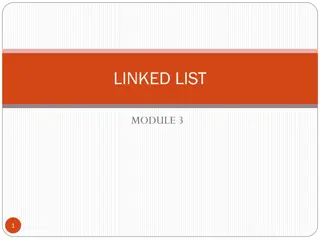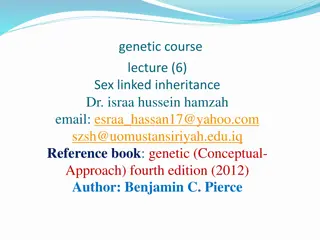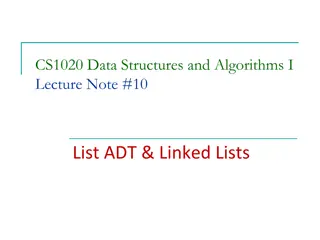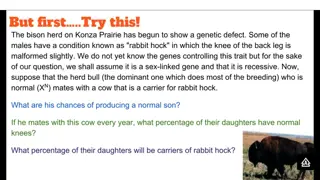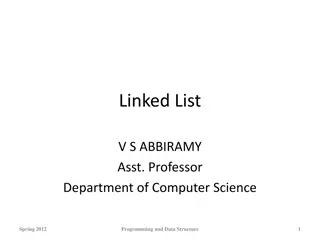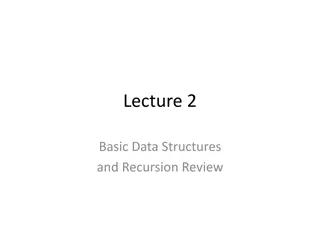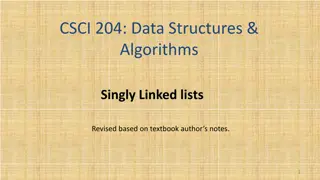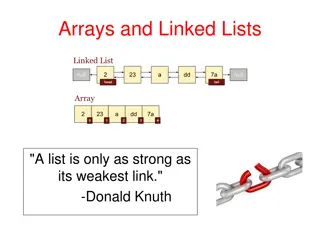
Understanding Linked Lists and Self-Referential Structures
Explore the concepts of linked lists, self-referential structures, and their practical applications in programming. Learn about creating, modifying, and managing linked list data structures efficiently.
Download Presentation

Please find below an Image/Link to download the presentation.
The content on the website is provided AS IS for your information and personal use only. It may not be sold, licensed, or shared on other websites without obtaining consent from the author. If you encounter any issues during the download, it is possible that the publisher has removed the file from their server.
You are allowed to download the files provided on this website for personal or commercial use, subject to the condition that they are used lawfully. All files are the property of their respective owners.
The content on the website is provided AS IS for your information and personal use only. It may not be sold, licensed, or shared on other websites without obtaining consent from the author.
E N D
Presentation Transcript
Linked List Sudeshna Sarkar Dept. of CSE, IIT KGP
Self Referential Structures A structure referencing itself how? So, we need a pointer inside a structure that points to a structure of the same type. struct list { int data; struct list *next; } ; typedef struct list ELEMENT; typedef ELEMENT * LINK; Dept. of CSE, IIT KGP
Linked Lists A singly linked list is a concrete data structure consisting of a sequence of nodes Each node stores element link to the next node next node elem NULL A B C D Dept. of CSE, IIT KGP
Linear Linked Lists head NULL A B C D Data type of head? Dept. of CSE, IIT KGP
42 98 12 6 heap stack head Dept. of CSE, IIT KGP
Linear Linked Lists tail head NULL A B C D Data type of head? Dept. of CSE, IIT KGP
Representation with Dummy Node head 10 17 Ignore dummy node Insertion at the beginning is the same as insertion after the dummy node Dept. of CSE, IIT KGP
Keeping track of a linked list: Must know the pointer to the first element of the list (called start, head, etc.). Linked lists provide flexibility in allowing the items to be rearranged efficiently. Insert an element. Delete an element. Spr ing 201 Programming and Data Structure 8 Dept. of CSE, IIT KGP
struct list a, b, c; a.data = 1; b.data = 2; c.data = 3; a.next = b.next = c.next = NULL; a b c 1 NULL 2 NULL 3 NULL data next data next data next Dept. of CSE, IIT KGP
Chaining these together a.next = &b; b.next = &c; a b c NULL 1 2 3 data next data next data next What are the values of : a.next->data a.next->next->data 2 3 Dept. of CSE, IIT KGP
Header file : list.h #include <stdio.h> #include <stdlib.h> typedef char DATA; struct list { DATA d; struct list * next; }; typedef struct list ELEMENT; typedef ELEMENT * LINK; Dept. of CSE, IIT KGP
Storage allocation LINK head ; head = malloc (sizeof(ELEMENT)); head->d = n ; head->next = NULL; creates a single element list. head n NULL Dept. of CSE, IIT KGP
Storage allocation head->next = malloc (sizeof(ELEMENT)); head->next->d = e ; head->next->next = NULL; A second element is added. head n e NULL Dept. of CSE, IIT KGP
Storage allocation head->next->next = malloc (sizeof(ELEMENT)); head->next->next->d = w ; head->next->next-> = NULL; We have a 3 element list pointed to by head. The list ends when next has the sentinel value NULL. head n e w NULL Dept. of CSE, IIT KGP
List operations (i) How to initialize such a self referential structure (LIST), (ii) how to insert such a structure into the LIST, (iii) how to delete elements from it, (iv) how to search for an element in it, (v) how to print it, (vi) how to free the space occupied by the LIST? Dept. of CSE, IIT KGP
Produce a list from a string (recursive version) #include list.h LINK StrToList (char s[]) { LINK head ; if (s[0] == \0 ) return NULL ; else { head = malloc (sizeof(ELEMENT)); head->d = s[0]; head->next = StrToList (s+1); return head; } } Dept. of CSE, IIT KGP
#include list.h LINK SToL (char s[]) { LINK head = NULL, tail; int i; if (s[0] != \0 ) { head = malloc (sizeof(ELEMENT)); head->d = s[0]; tail = head; for (i=1; s[i] != \0 ; i++) { tail->next = malloc(sizeof(ELEMENT)); tail = tail->next; tail->d = s[i]; } tail->next = NULL; } return head; list from a string (iterative version) Dept. of CSE, IIT KGP }
Inserting at the Head 1. Allocate a new node 2. Insert new element 3. Make new node point to old head 4. Update head to point to new node Linked Lists 18 Dept. of CSE, IIT KGP
Removing at the Head 1. Update head to point to next node in the list 2. Allow garbage collector to reclaim the former first node Linked Lists 19 Dept. of CSE, IIT KGP
Linear Linked List with tail tail head NULL A B C D Dept. of CSE, IIT KGP
Inserting at the Tail 1. Allocate a new node 2. Insert new element 3. Have new node point to null 4. Have old last node point to new node 5. Update tail to point to new node Linked Lists 21 Dept. of CSE, IIT KGP
Removing at the Tail Removing at the tail of a singly linked list cannot be efficient! There is no constant-time way to update the tail to point to the previous node Linked Lists 22 Dept. of CSE, IIT KGP
Insertion To insert a data item into an ordered linked list involves: creating a new node containing the data, finding the correct place in the list, and linking in the new node at this place. Dept. of CSE, IIT KGP
Example of an Insertion first prev ptr 3 5 8 12 - new 7 Createnew node for the 7 Find correct place when ptr finds the 8 (7 < 8) Link in new node with previous (even if last) and ptr nodes Also check insertion beforefirst node! Dept. of CSE, IIT KGP
Header file : list.h #include <stdio.h> #include <stdlib.h> struct list { int data; struct list * next; }; typedef struct list ELEMENT; typedef ELEMENT * LINK; Dept. of CSE, IIT KGP
Create_node function Link create_node(int data) { LINK new; new = (LINK) malloc (sizeof (ELEMENT)); new -> data = data; return (new); } Dept. of CSE, IIT KGP
Adding an Element to a Linked List Involves two steps: Finding the correct location Three possible positions: The front The end Somewhere in the middle Doing the work to add the node Dept. of CSE, IIT KGP
Inserting to the Front head 48 17 142 93 head There is no work to find the correct location Empty or not, head will point to the right location Dept. of CSE, IIT KGP
Inserting to the End //93 // head 48 17 142 Find the end of the list (when at NIL) Recursion or iteration Dept. of CSE, IIT KGP
Inserting to the Middle // // head 17 48 142 93 142 Used when order is important Go to the node that should follow the one to add Recursion or iteration Dept. of CSE, IIT KGP
The Work to Add the Node typedef struct stud { int roll; char name[25]; int age; struct stud *next; } node; node *head; Create the new node Fill in the data field Deal with the next field Point to nil (if inserting to end) Point to current (front or middle) newnode = (node *) malloc(sizeof(node)); newnode->data = new_data newnode->next = current ; current = newnode; Dept. of CSE, IIT KGP
Three Types of Insertion To front To end Get to the end, then add node In middle Get to the node before which the new node is to be inserted. Dept. of CSE, IIT KGP
insert at front LINK insertfront (int data, LINK head) { LINK new, prev, first; new = create_node(data); new -> next = ptr; return new; // return pointer to first node } Dept. of CSE, IIT KGP
Insert to end LINK insertend (int data, LINK ptr) { LINK new, head; new = create_node(data); head = ptr; if (ptr == NULL ) { new -> next = NULL; return new; } while (ptr->next != NULL) ptr = ptr -> next; ptr -> next = new; new -> next = NULL; return head; } Dept. of CSE, IIT KGP
Sorted insert function LINK insert (int data, LINK ptr) { LINK new, prev, first; new = create_node(data); if (ptr == NULL || data < ptr -> value){ // insert as new first node new -> next = ptr; return new; // return pointer to first node } Dept. of CSE, IIT KGP
else{ // not first one first = ptr; prev = ptr; ptr = ptr -> next; // second while (ptr != NULL && data > ptr -> data) { prev = ptr; ptr = ptr -> next; } prev -> next = new; // link in new -> next = ptr; //new node return first; } // end else // end insert } // remember start Dept. of CSE, IIT KGP
Deletion To delete a data item from a linked list involves (assuming it occurs only once!): finding the data item in the list, and linking out this node, and freeing up this node as free space. Dept. of CSE, IIT KGP
Example of Deletion first prev ptr - 3 5 8 12 When ptr finds the item to be deleted, e.g. 8, we need the previous node to make the link to the next one after ptr (i.e. ptr -> next). Also check whether first node is to be Dept. of CSE, IIT KGP deleted.
// delete the item from ascending list LINK delete_item(int data, LINK ptr) { LINK prev, first; first = ptr; // remember start if (ptr == NULL) { return NULL; } else if (data == ptr -> data) // first node { ptr = ptr -> next; free(first); return ptr; } // second node // free up node // second Dept. of CSE, IIT KGP
else // check rest of list { prev = ptr; ptr = ptr -> next; while (ptr != NULL && data > ptr->data) { prev = ptr; ptr = ptr -> next; } // find node to delete Dept. of CSE, IIT KGP
} if (ptr == NULL || data != ptr->data) // NOT found in ascending list // nothing to delete { return first; // original } else // found, delete ptr node { prev -> next = ptr -> next; free(ptr); return first; // original } } // end delete // free node Dept. of CSE, IIT KGP
Representation with Dummy Node head dummy node Insertion at the beginning is the same as insertion after the dummy node Dept. of CSE, IIT KGP
Initialization head Write a function that initializes LIST typedef struct list { int data; struct list *next; } ELEMENT; ELEMENT* Initialize (int element) { ELEMENT *head; head = (ELEMENT *)malloc(sizeof(data)); // Create initial node head->data = element; head -> next = NULL; return head; } Dept. of CSE, IIT KGP
Insert head head Dept. of CSE, IIT KGP
ELEMENT* Insert(ELEMENT *head, int element, int position) { int i=0; ELEMENT *temp, *new; if (position < 0) { printf("\nInvalid index %d\n", position); return head; } temp = head; for(i=0;i<position;i++){ temp=temp->next; if(temp==NULL) { printf("\nInvalid index %d\n", position); return head; } } new = (ELEMENT *)calloc(1,sizeof(ELEMENT)); new ->data = element; new -> next = temp -> next; temp -> next = new; return head; } Dept. of CSE, IIT KGP
head Delete temp head temp Dept. of CSE, IIT KGP
ELEMENT* Delete(data *head, int position) { int i=0;data *temp,*hold; if (position < 0) { printf("\nInvalid index %d\n", position); return head; } temp = head; while ((i < position) && (temp -> next != NULL)) { temp = temp -> next; i++; } if (temp -> next == NULL) { printf("\nInvalid index %d\n", position); return head; } hold = temp -> next; temp -> next = temp -> next -> next; free(hold); return head; } Dept. of CSE, IIT KGP
Searching a data element int Search (ELEMENT *head, int element) { int i; ELEMENT *temp; i = 0; temp = head -> next; while (temp != NULL) { if (temp -> x == element) return TRUE; temp = temp -> next; i++; } return FALSE; } Dept. of CSE, IIT KGP
Printing the list void Print (ELEMENT *head) { ELEMENT *temp; temp = head -> next; while (temp != NULL) { printf("%d->", temp -> data); temp = temp -> next; } } Dept. of CSE, IIT KGP
Print the list backwards . head How can you when the links are in forward direction ? Can you apply recursion? Dept. of CSE, IIT KGP



